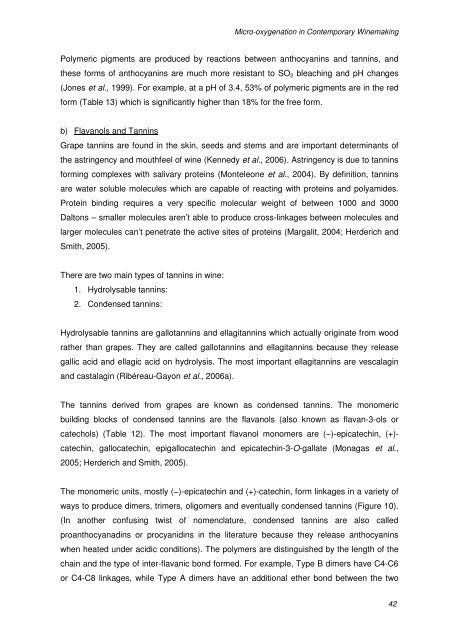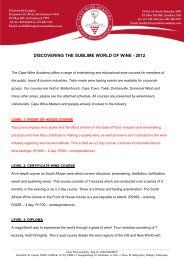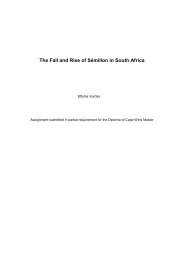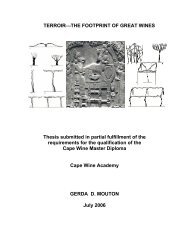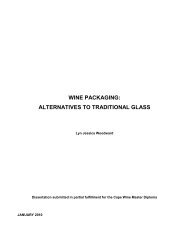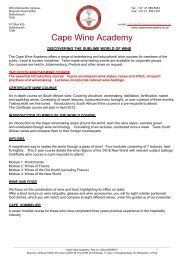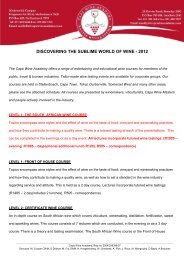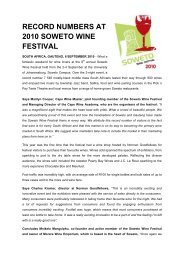micro-oxygenation in contemporary winemaking - Cape Wine ...
micro-oxygenation in contemporary winemaking - Cape Wine ...
micro-oxygenation in contemporary winemaking - Cape Wine ...
Create successful ePaper yourself
Turn your PDF publications into a flip-book with our unique Google optimized e-Paper software.
Micro-<strong>oxygenation</strong> <strong>in</strong> Contemporary W<strong>in</strong>emak<strong>in</strong>gPolymeric pigments are produced by reactions between anthocyan<strong>in</strong>s and tann<strong>in</strong>s, andthese forms of anthocyan<strong>in</strong>s are much more resistant to SO 2 bleach<strong>in</strong>g and pH changes(Jones et al., 1999). For example, at a pH of 3.4, 53% of polymeric pigments are <strong>in</strong> the redform (Table 13) which is significantly higher than 18% for the free form.b) Flavanols and Tann<strong>in</strong>sGrape tann<strong>in</strong>s are found <strong>in</strong> the sk<strong>in</strong>, seeds and stems and are important determ<strong>in</strong>ants ofthe astr<strong>in</strong>gency and mouthfeel of w<strong>in</strong>e (Kennedy et al., 2006). Astr<strong>in</strong>gency is due to tann<strong>in</strong>sform<strong>in</strong>g complexes with salivary prote<strong>in</strong>s (Monteleone et al., 2004). By def<strong>in</strong>ition, tann<strong>in</strong>sare water soluble molecules which are capable of react<strong>in</strong>g with prote<strong>in</strong>s and polyamides.Prote<strong>in</strong> b<strong>in</strong>d<strong>in</strong>g requires a very specific molecular weight of between 1000 and 3000Daltons – smaller molecules aren’t able to produce cross-l<strong>in</strong>kages between molecules andlarger molecules can’t penetrate the active sites of prote<strong>in</strong>s (Margalit, 2004; Herderich andSmith, 2005).There are two ma<strong>in</strong> types of tann<strong>in</strong>s <strong>in</strong> w<strong>in</strong>e:1. Hydrolysable tann<strong>in</strong>s:2. Condensed tann<strong>in</strong>s:Hydrolysable tann<strong>in</strong>s are gallotann<strong>in</strong>s and ellagitann<strong>in</strong>s which actually orig<strong>in</strong>ate from woodrather than grapes. They are called gallotann<strong>in</strong>s and ellagitann<strong>in</strong>s because they releasegallic acid and ellagic acid on hydrolysis. The most important ellagitann<strong>in</strong>s are vescalag<strong>in</strong>and castalag<strong>in</strong> (Ribéreau-Gayon et al., 2006a).The tann<strong>in</strong>s derived from grapes are known as condensed tann<strong>in</strong>s. The monomericbuild<strong>in</strong>g blocks of condensed tann<strong>in</strong>s are the flavanols (also known as flavan-3-ols orcatechols) (Table 12). The most important flavanol monomers are (−)-epicatech<strong>in</strong>, (+)-catech<strong>in</strong>, gallocatech<strong>in</strong>, epigallocatech<strong>in</strong> and epicatech<strong>in</strong>-3-O-gallate (Monagas et al.,2005; Herderich and Smith, 2005).The monomeric units, mostly (−)-epicatech<strong>in</strong> and (+)-catech<strong>in</strong>, form l<strong>in</strong>kages <strong>in</strong> a variety ofways to produce dimers, trimers, oligomers and eventually condensed tann<strong>in</strong>s (Figure 10).(In another confus<strong>in</strong>g twist of nomenclature, condensed tann<strong>in</strong>s are also calledproanthocyanad<strong>in</strong>s or procyanid<strong>in</strong>s <strong>in</strong> the literature because they release anthocyan<strong>in</strong>swhen heated under acidic conditions). The polymers are dist<strong>in</strong>guished by the length of thecha<strong>in</strong> and the type of <strong>in</strong>ter-flavanic bond formed. For example, Type B dimers have C4-C6or C4-C8 l<strong>in</strong>kages, while Type A dimers have an additional ether bond between the two42


